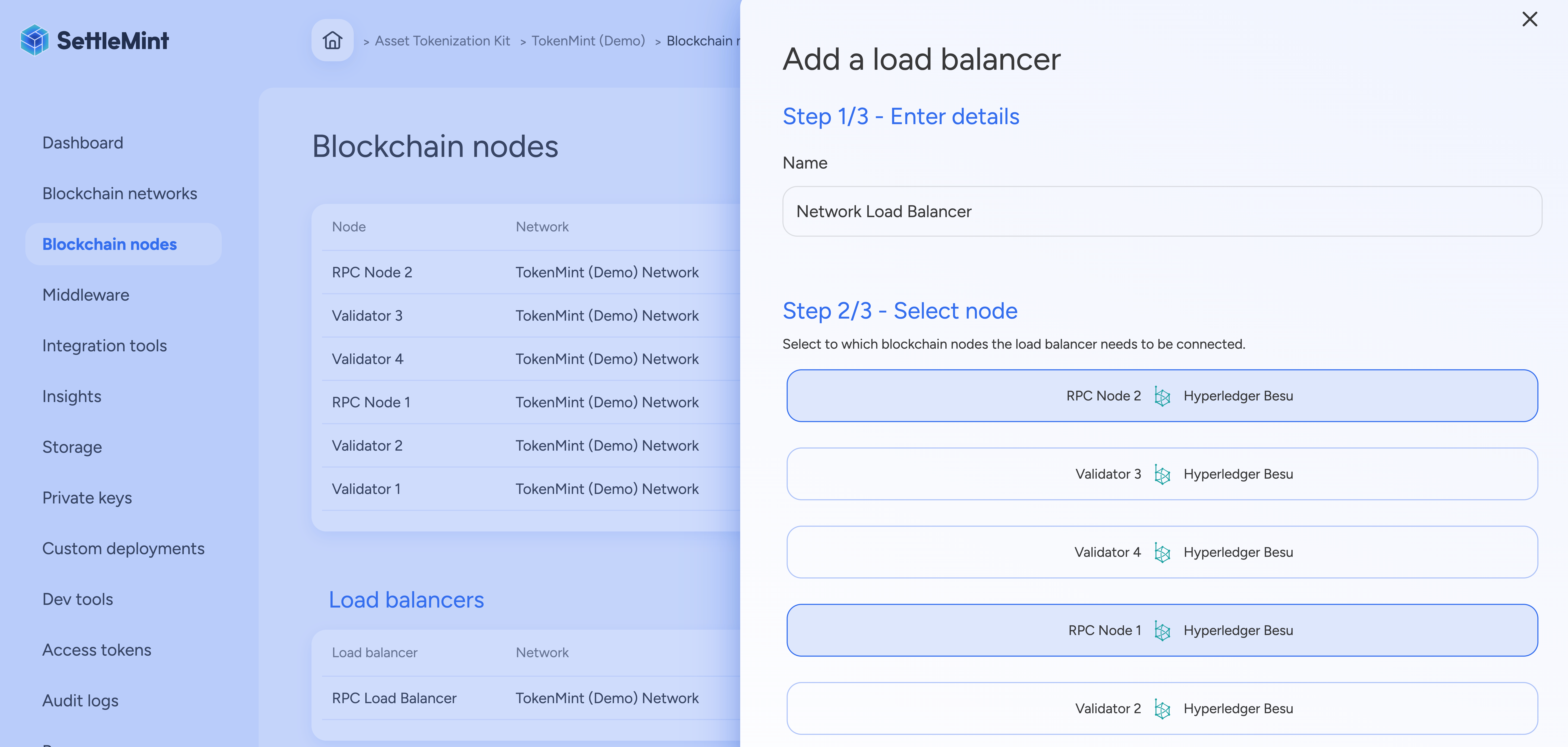Load Balancer
Complete guide to blockchain load balancing for enterprise applications. Learn to distribute traffic across nodes, ensure 99.9% uptime, and optimize performance with SettleMint's intelligent load balancing.
A blockchain load balancer is a networking component designed to distribute traffic efficiently across multiple blockchain nodes to optimize performance, reliability, and scalability. It ensures that transaction requests, queries, and smart contract interactions are handled efficiently, preventing overloading on any single node. Load balancing is particularly important in blockchain environments where multiple nodes serve API requests for wallets, dApps, and enterprise applications. By intelligently routing requests, a blockchain load balancer enhances availability, fault tolerance, and transaction throughput. A blockchain load balancer operates as an intermediary layer between blockchain clients (wallets, dApps, APIs) and backend blockchain nodes. It ensures that requests are distributed efficiently based on predefined rules, improving performance and resilience.
Key steps in load balancing:
- Incoming Request Handling – The load balancer receives API requests from users, smart contracts, or external applications.
- Node Health Check – It continuously monitors node health, availability, and performance to route traffic efficiently.
- Request Distribution – Transactions and queries are forwarded to the most appropriate blockchain node using load-balancing strategies.
- Response Management – The selected node processes the request and returns the response to the client.
- Failover Handling – If a node becomes unresponsive, the load balancer automatically reroutes requests to healthy nodes.
Settlemint blockchain platform: load balancer

SettleMint provides an integrated blockchain load balancer to optimize the
performance of blockchain networks deployed on its platform. The load balancer
ensures high availability, fault tolerance, and scalable performance by
distributing traffic across multiple blockchain nodes.
SettleMint employs a multi-layered application aware load balancing strategy to
ensure optimal performance and network resilience. Our approach dynamically
adapts to varying workloads and network conditions, ensuring seamless
transaction processing and high availability. By leveraging a combination of
intelligent request distribution and fault-tolerant mechanisms, we optimize
efficiency while maintaining a robust and scalable blockchain environment. This
feature is particularly beneficial for applications that require high
throughput, low latency, and continuous uptime in blockchain transactions and
queries.
The SettleMint blockchain load balancer intelligently routes transaction and API requests across active nodes based on network health, workload distribution, and failover mechanisms.
Load balancer process in settlemint:
- Traffic Reception – The load balancer receives requests from users, smart contracts, and external systems.
- Node Monitoring & Health Check – It continuously checks node availability, latency, and processing load.
- Intelligent Routing – Requests are distributed based on real-time node performance using strategies like round-robin, least connections, or weighted routing.
- Failover Protection – If a node goes offline, the load balancer automatically redirects traffic to healthy nodes, ensuring uninterrupted blockchain operations.
- Response Handling – The processed response is returned to the client from the assigned node.
Features of settlemint’s blockchain load balancer
- Auto-Scaling Support – Dynamically adds or removes nodes to optimize resource usage.
- High Availability – Ensures continuous uptime by redirecting requests to healthy nodes.
- Performance Optimization – Reduces network congestion by balancing workloads effectively.
- Multi-Protocol Support – Compatible with Ethereum JSON-RPC, Hyperledger Fabric APIs, and custom blockchain endpoints.
- Security & Rate Limiting – Protects against DDoS attacks and excessive API calls.
Deployment options
SettleMint allows flexible deployment of its blockchain load balancer based on the specific needs of an organization:
1. Cloud-based load balancer
- Deployed on cloud infrastructure (AWS, Azure, GCP) with auto-scaling capabilities.
- Ideal for enterprise-grade blockchain solutions.
2. On-premises load balancer
- Runs within a private network for enhanced security and regulatory compliance.
- Suitable for financial, government, and enterprise applications.
3. Hybrid load balancer
- A combination of cloud and on-prem nodes to balance traffic dynamically.
- Enables cost efficiency and scalability while ensuring data privacy.
Security considerations
When implementing a blockchain load balancer, security must be a top priority. SettleMint incorporates the following best practices:
- API Rate Limiting: Prevents misuse by limiting excessive transaction requests.
- Node Authentication & Access Control: Ensures only authorized users can interact with nodes.
- DDoS Protection: Detects and mitigates distributed denial-of-service (DDoS) attacks.
- Encrypted Communications: Uses TLS encryption for secure node-to-node communication.